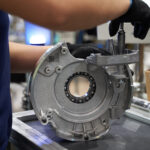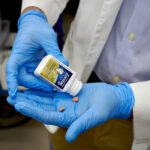We are still years away from full implementation of true self-driving cars in the U.S., but each step we take dramatically complicates and changes the face of auto claims handling, vehicle repairs, and subrogation litigation.
When catastrophic claims are paid as a result of a traffic accident resulting from a failure of an automated driving system (ADS) and subrogation enters the picture, it is no longer a simple question of who had the right-of-way and who failed to yield. Products malfunction and computers fail. Simple auto subrogation has now entered the more complex and exponentially more expensive world of product liability. Automobile accident subrogation is rapidly changing, and the insurance industry will need to change with it.
I appeared on a national radio program a couple of years ago, hosted by Ringler Radio and Larry Cohen, titled “Driverless Car Litigation.” The discussion was on the ever-changing intersection between the exploding industry of self-driving/autonomous vehicles, the rising cost and complexity involving the labor necessary to repair damaged vehicles and the growing complexity of subrogation litigation.
Listen to the interview in its entirety

The latest innovations in driverless cars were discussed, along with their likely impact on the insurance industry and underwriting. Even trial lawyers will have to adapt to the changing face of automobile accidents and injuries which involve self-driving vehicles. “The future starts today, not tomorrow,” Pope John Paul II famously said. He was right. Driverless cars – more appropriately known as “autonomous vehicles” – have arrived. But is the industry ready for them?
The evolution of automotive technology has evolved at light speed and a future with automated driving systems that will completely manage the task of driving is right around the corner. Currently, no vehicles for sale in the U.S. are “self-driving.” Advanced ADS systems such as Tesla Autopilot, Ford BlueCruise, and GM SuperCruise are not “self-driving.” Rather, they are referred to as “Level 2 capable,” in which the driver can briefly ignore some driving responsibilities but must be alert and always ready to take over. J.D. Power Magazine online describes the levels of autonomous driving as follows:
“If a vehicle has Level 0, Level 1, or Level 2 driver support systems, an active and engaged driver is required. She is always responsible for the vehicle’s operation, must supervise the technology at all times, and must take complete control of the vehicle when necessary. In the future, if a vehicle has Level 3, Level 4, or Level 5 automated driving systems, the technology takes complete control of the driving without human supervision. However, with Level 3, if the vehicle alerts the driver and requests, she takes control of the vehicle, she must be prepared and able to do so.”
The debate over how long it will take to have fleets of truly self-driving vehicles traversing our freeways is lively and estimates range from a few years to a generation or two. The majority of vehicles on the road currently are level 0, but a rapidly growing number of cars feature Level 1 and 2 ADS systems. The leap from Level 2 to Level 3 automation is so significant that no Level 3 systems are currently legal to use on American roads, but they are coming.
The National Highway Traffic Safety Administration is preparing for the fully automated vehicles and accepted comments on the development of administrative safety for ADS systems until Feb. 1, 2021. They have published several research reports, guidance documents, and notices of advanced rulemaking. Their main task is to determine which requirements of the existing Federal Motor Vehicle Safety Standards are relevant to the safety needs of ADS-equipped vehicles without traditional manual controls, and then adapting or developing the requirements and the associated test procedures so that the requirements can effectively be applied to the novel vehicle designs that may accompany such vehicles without adversely affecting safety.
When it comes to the adjusting of claims and handling of automobile subrogation matters, simple auto accidents are now becoming increasingly complex—mechanically and legally. From the nuances of advanced ADS systems to cyber security; there will be a growing number of failures and challenges. In 2015, hackers wirelessly accessed the braking and steering system of a Jeep through its onboard entertainment system and forced it to stop on a St. Louis highway while driving at 70 mph. Autonomous vehicle manufacturers are struggling to interface autonomous vehicles with the traditional human-driven vehicles on the highway, and an entire insurance underwriting industry is struggling to evaluate the risks which everybody knows are there.
Amazing ADS advancements are being revealed every day. Last year, Honda Motor Company announced its Legend Hybrid EX Honda Sensing Elite as the first production vehicle capable of Level 3 conditional automated driving as approved by the Japanese government. Referred to as Honda Sensing Elite with Traffic Jam Pilot, this advanced ADS system allows the vehicle to self-drive in certain situations, including on freeways. When used in conjunction with lane keeping assist, the vehicle can be operated hands-free with Traffic Jam Pilot. With the Active Lane Change function activated, the vehicle will switch lanes and even pass vehicles without driver assistance. Honda is so confident in the system that it does the unthinkable and has publicly stated that the driver “does not have to pay attention to the road until prompted to do so.” After the prompt, the driver must be ready to take back control immediately or it will eventually slow and stop the car after multiple alerts.
In 2017, Audi developed and hailed a Level 3 system similar to Honda’s for its Audi A8 sedan. This ADS was called Traffic Jam Pilot just like Honda’s. This technology worked on divided highways, and claimed it would accelerate, stop, and steer by itself at speeds of up to 37 mph, at which point the system reverted to a Level 2 adaptive cruise control ADS. The plan was to release this technology in countries which approved it, but most government agencies weren’t able to react quickly enough, and Audi had to give up its plans to offer it on the A8.
The features available on the new Mercedes E-Class, some of which are standard, some requiring the Driver Assistance Package, are more the stuff of H.G. Wells than Gottlieb Daimler. They include:
- Drive Pilot’s adaptive cruise control (Distronic) and Steering Pilot (lane keep assist) track the car in front at speeds up to 130 mph (210 kph) and can stay lane-centered at up to 81 mph (130 kph). It tracks nearby vehicles and senses highway lane markings.
- Active Lane Change Assist is a radar- and camera-based system that semi-automates lane changes. Flip the directional signal and the car waits two seconds and then changes lanes on its own.
- Active Brake Assist with cross-traffic function similarly has “extended speed thresholds” for detecting cars and pedestrians. The car brakes if it detects crossing traffic that you aren’t slowing for and will initiate advance braking if it senses you’ve come upon the tail end of traffic jam, where there’s no room to maneuver.
- Evasive Steering Assist works with pedestrian detection to help the driver steer around a pedestrian and then apply steering wheel torque (force) to recover and get the straightened out afterwards.
- Active Blind Spot Assist (blind spot detection), in addition to highway speed warning, can warn of possible city-speed lateral (side) collisions.
- Pre-Safe Sound emits a sharp “interference signal” through the sound system if it detects an impending collision. It triggers a biological reflex in the human ear that prepares the occupants for the sound of the collision if it happens.
- Remote Parking Pilot pulls the car out of a garage or parking space using a smartphone app, with the driver outside. This lets big cars park in narrow spaces and tiny garages.
- Car-to-X communication is the first car with integral car-to-X, meaning car-to-anything communications where a connected car ahead helps cars behind “see” around corners or through obstacles.
Admittedly, the Drive Pilot will be used primarily on highways and country roads. The new Mercedes-Benz E-Class technically doesn’t “drive itself,” but it sure seems like it. The new technology promises a future where computers drive cars, rather than humans, eliminating error and reducing accidents and injuries exponentially. Between now and then, however, we will have a prolonged “trial” period where these “self-driving” cars interact with and attempt to anticipate the foible of human negligence.
Mercedes-Benz’s Distronic Plus system operates by using radar sensors that scans traffic for stopped or slowing traffic. If the system senses that a collision is imminent, its PRE-SAFE Brake feature automatically initiates up to 40% braking power, audibly alerts the driver, and engages the PRE-SAFE system. When the driver brakes, 100% braking pressure is instantly applied. If the driver fails to respond, the system can apply full braking on its own, serving as an “electronic crumple zone” to help reduce the intensity of a collision. An April 2012 Highway Loss Data Institute Bulletin credited Distronic Plus with a 14% reduction in property damage claims. Vehicle-to-vehicle communication technology will allow your car to continually download information uploaded from other “intelligent” vehicles from the Cloud, informing it of slow-downs and accidents which are unseen to the human eye around the corner or over a hill.
Trial lawyers are chomping at the bit in anticipation of new litigation opportunities and deeper pockets than a state’s minimum liability limits. Claims and subrogation adjusters should be right there alongside them. Subrogation professionals must be able to understand and diagnose potential ADS failures which contribute to vehicle accidents and proceed accordingly. Product liability subrogation counsel may be necessary where previously two claims handlers argued about who had the red light. This changes the game completely.
New technologies and rising labor costs merge to create significantly increased vehicle repair costs, extended repair times, and more expensive components which need to be replaced. Previous state minimum insurance limits (first-party and third-party) will have to be rethought and retooled. The property/casualty insurance industry will need to be nimble in adapting to the fast rate of change, and subrogation professionals will also need to be well-trained and aggressive. Costs to repair increasingly complex vehicles are rapidly on the rise, and the truly complex stuff hasn’t even hit the assembly line yet.
Autonomous driving means another growth period involving the uncomfortable interface between computer-driven vehicles and older models driven by potential tortfeasors. In the horse and buggy era, as the number of vehicles increased, the rate of deaths and injuries caused by vehicular accidents rose tremendously. By 1917, Detroit had 65,000 cars on the road, resulting in 7,171 accidents and 168 fatalities.
Lawyers are trained to look at a tragedy and think, “how could this have been prevented?” When they have their answer, they draft their complaint. With so many moving parts and unproven technology, the answer to the lawyers’ question when an autonomous vehicle is involved will often lead them to blame the product, rather than the driver. And liability claims which previously required only common sense and a working knowledge of traffic laws to handle may now necessitate advanced degrees and an entirely new level of investment.
Strict product liability law provides the legal remedy when a defective product (defect in design or manufacture) causes damage, injury, or death. Product manufacturers have a legal duty to carefully design their products in a way that reasonably foresees risks of injury to those using their product reasonably. If little or no driver interaction is required with driverless cars, a myriad of conditions or combination of conditions could combine to cause an accident – even if it involves a foreseeable human operator panicking and interfering with the vehicle’s automation. Consumers may even begin to rely too much on these early autonomous vehicles, leading to collisions resulting from inattentiveness.
The number of theories of legal liability available to trial lawyers and subrogated insurance carriers increases exponentially as the technology of these new “self-driving” cars grows. It will require thinking outside of the box. Claims professionals will need to become familiar with the technology involved and develop a relationship with qualified automotive experts. As Robert Greene—an American author known for his books on corporate strategy—famously said, “The future belongs to groups that are fluid, fast, and nonlinear.”
Wickert is a shareholder with Matthiesen, Wickert & Lehrer, S.C. With nearly four decades of litigation experience, he is the author of several subrogation books and legal treatises. Those with questions may contact Wickert at gwickert@mwl-law.com.
Was this article valuable?
Here are more articles you may enjoy.

 Auto Lobbying Groups Unite to Pressure Trump for Tariff Relief
Auto Lobbying Groups Unite to Pressure Trump for Tariff Relief  GSK Zantac Appeal Gets Tough Questions From Some US Judges
GSK Zantac Appeal Gets Tough Questions From Some US Judges  In Fight Over Insurance, Neighbors Crowdsource LA Fire Contamination Data
In Fight Over Insurance, Neighbors Crowdsource LA Fire Contamination Data  FBI Says Cybercrime Costs Rose to at Least $16 Billion in 2024
FBI Says Cybercrime Costs Rose to at Least $16 Billion in 2024 